11 Tips On How To Run A Global Team Engagement Program
In the dynamic and interconnected world we live in, the expansion of global teams has emerged as a strong trend, reflecting the growing reach and ambitions of multinational companies. As these organizations venture beyond borders, it becomes vital to forge effective connections and foster global team engagement, considering various time zones and cultural backgrounds.
In this blog, we explore effective strategies for managing a global team engagement program, providing valuable insights to enhance collaboration and motivation among dispersed teams across different locations and time zones.
Key Takeaways
- Why do we need a global team engagement program?
- What does global team engagement encompass?
- 11 tips for running a successful global team engagement program.
What is a Global Team?
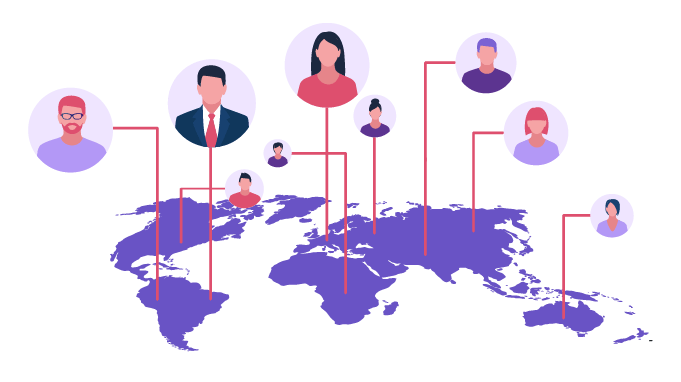
A group of individuals working together on a single project or goal while being spread out over many international locations is known as a global team. Members of these teams frequently come with various cultural backgrounds, time zones, and perhaps even native languages.
Global teams can be found in big multinational corporations or smaller companies with a global presence.
Global team engagement encompasses a team's collective enthusiasm, motivation, and active participation. It empowers them to connect, collaborate, and perform at their best, regardless of geographical dispersion. Simply put, global team engagement unlocks the full potential of a global team and drives organizational success in an interconnected world.
Why Do We Need a Global Team Engagement Program?
Building strong relationships across borders is essential for global team success. It's about understanding and embracing cultural differences while finding common ground to collaborate effectively. -Satya Nadella
Engagement programs are singularly designed to foster a strong connection between employees and the organization, leading to improved motivation, increased job satisfaction , and higher retention rates.
Working along the same lines, global team engagement programs aim to achieve stronger collaboration and connections while breaking down barriers across dispersed teams.
Before we proceed, let's glimpse at some of the challenges that global organizations face and how a global team engagement program can help:
- Building a sense of teamwork and collaboration among geographically scattered employees can be challenging.
- Team members can easily feel disconnected from their coworkers if they don't contact face to face often.
- Additionally, communication can become more difficult due to linguistic and cultural obstacles, resulting in misunderstandings and disputes.
Managing a Global Team Engagement Program
Engaging multinational teams goes beyond than just leading frequent online team-building exercises. It entails understanding that the culturally diverse members of your workforce have unique personalities and needs. They all engage, collaborate, and approach challenges differently.
Read our blog on: The Modern Rules for Teamwork in the Workplace
We will go into detail about each of these, but first, let's go through the benefits of managing a worldwide team engagement program. Here are some ways a global team engagement program can benefit a geographically dispersed team:
Better communication
A global team engagement program can assist in reducing communication barriers between team members by allowing them to communicate and share ideas.
Enhanced cultural awareness
A global team engagement program can give team members a chance to learn about one another's cultures, traditions, and values, increasing their cultural awareness. It can enhance the team's capacity to collaborate productively across cultural barriers.
Increased innovation
A global team engagement program can give team members the much-needed boost to acknowledge and hear different viewpoints and experiences. With that, organizations can tap into a rich pool of insights and drive forward-thinking innovation within the company.
Better performance
Team members are more likely to be enthusiastic, aligned to their goals and perform at a high level when they feel connected to their work and coworkers.
Increased sense of belonging
Being a part of a global team might occasionally feel lonely because team members may not have as many opportunities to form friendships and connections with other people as they would in a team that is physically based together. A worldwide team engagement program can support the development of a sense of community and belonging among team members, which can enhance retention and job satisfaction.
Thus, implementing a global team engagement program can bring a range of benefits to your company, but to truly realize its potential, it's essential to run the program effectively.
11 Tips for Running a Successful Global Team Engagement Program
HR needs bold ideas, not old ideas.
Running a successful global team engagement program requires careful planning and thoughtful implementation. The following tips can help organizations elevate global team engagement and succeed in a globalized work environment.
1. Set SMART objectives
A goal properly set is halfway reached.- Zig Ziglar
When setting objectives for a global engagement program, SMART (Specific, Measurable, Achievable, Relevant, and Time-Bound) goals can help ensure clarity, focus, and measurability.
Here's how SMART goals can translate into setting better objectives for your program:
Specific: Clearly define the desired outcome for team engagement, such as improving collaboration and communication among global team members. For example, instead of a vague objective like "Increase global engagement," make it specific by stating, "Increase the number of active participants in our global engagement program by 20% within the next year."
Measurable: Set objectives that can be quantified, such as increasing the number of cross-functional projects or reducing response time to global team inquiries. Using the previous example, you can measure the number of active participants before and after the program implementation and compare it to the 20% target.
Achievable: Balance ambitious goals with practicality, considering factors like time zones, language barriers, and cultural differences that may impact engagement efforts. Like say, setting an objective to increase global engagement by 200% within a month may not be achievable, but a 20% increase over a year may be more realistic.
Relevant: Ensure your objectives align with your global engagement program's overall purpose and strategy. They should directly contribute to the program's goals and mission. Evaluate the significance of each objective and its potential impact on your organization's global engagement efforts.
Time-bound: Set deadlines to create a sense of urgency and establish a timeline for evaluating the effectiveness of engagement initiatives and making necessary adjustments. For example, you have set a deadline of one year for achieving a 20% increase in active participants.
Create a 'SMART Goal Passport': Treat your team's goal-setting process as a travel adventure! Each team member can fill in their 'SMART Goal Passport' with their own goals and aspirations for the team. Encourage them to get creative by using travel-inspired imagery, stamps, or stickers to personalize their passports. It will add fun and an engaging twist to your global team engagement.
2. Keep effective communication channels
Global team engagement relies on effective communication due to the dispersed nature of team members across different time zones and geographic regions.
Therefore, picking the appropriate communication tools to encourage teamwork and connection is crucial.
This is important because not all tools may be accessible in all nations or locations, accessibility should be considered when choosing communication tools. It's also crucial to take into account the cultural background of the team as well as the preferences of the team members, as some may feel more at ease using particular tools or communication styles than others.
You can use video conferencing, instant messaging, social networking, and other digital platforms to engage a global team effectively. However, you should pick the one that suits your team’s needs the best.
Gallup has said for the past several years that we are in a “Global engagement crisis.” It’s true. And never has engagement been so important to employees and sustainable business practices. We simply can’t afford to be disengaged anymore.
3. Use a rewards and recognition platform
Recognition and rewards play a pivotal role in global team engagement programs by reinforcing a culture of appreciation and driving increased motivation among dispersed team members. These initiatives recognize and celebrate individual and collective achievements, fostering a sense of value and belonging, and ultimately leading to higher levels of engagement across diverse geographical boundaries.
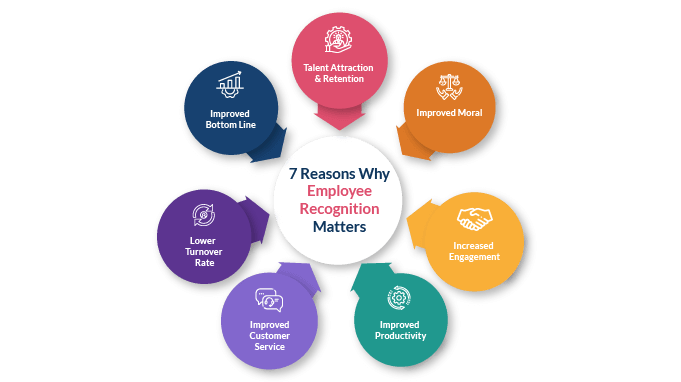
One effective way to implement a rewards and recognition program for global teams is to use an efficient employee rewards and recognition platform that is not only adaptable but has the capability to offer customized rewards catering to various needs of the organization.
Vantage Circle offers a seamless solution for managers to establish personalized rewards programs that cater to their team's specific requirements, irrespective of location.
Best part, the employees can flaunt the recognition on varios social media platforms
Whether milestone achievements, performance-based recognition, or peer-to-peer appreciation, the platform allows customization to align with the team's diverse needs and preferences.
This flexibility enables managers to consider business value, establishment, and cultural nuances when designing the rewards and recognition program, ensuring it resonates effectively with their global workforce.
4. Check the efficiency of your rewards and recognition program
Many global organizations approach recognition programs as merely a corporate exercise without clear metrics or measurement of impact.
However, if recognition programs are not authentic, impactful, or aligned with the company culture, they may fail to resonate with global team members. This misalignment can result in conflicting outcomes and ultimately reduce team members' engagement and motivation.
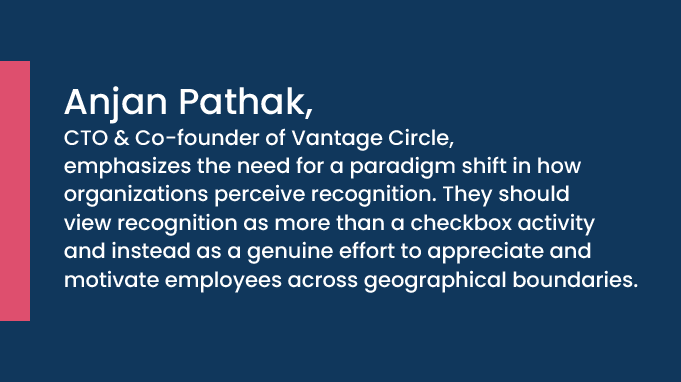
The AIRe Framework for Employee Recognition aims to enable the effective implementation of valuable workplace recognition.
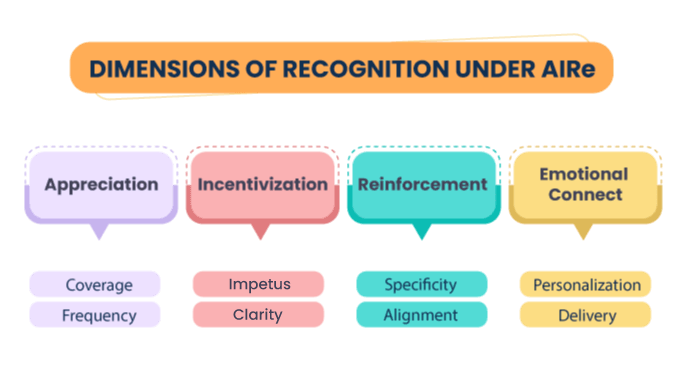
The AIRe Framework is centered around Appreciation (A), Incentivization (I), and Reinforcement (R), with Emotional Connect (e) serving as the motivating factor. This framework emphasizes the importance of recognition in the workplace and highlights how it is vital for employees to feel valued and thrive.
By applying the AIRe Framework, organizations can assess the existing recognition culture within their company and pinpoint areas that require enhancement. If a company lacks a recognition program, it can use this framework to develop and establish a robust policy.
Read this whitepaper on the AIRe framework for implementing employee recognition programs more rationally.
Also, try our AIRe self-assessment tool for checking the impact & authenticity of your Rewards & Recognition Program.
5. Introduce a social feed for your team
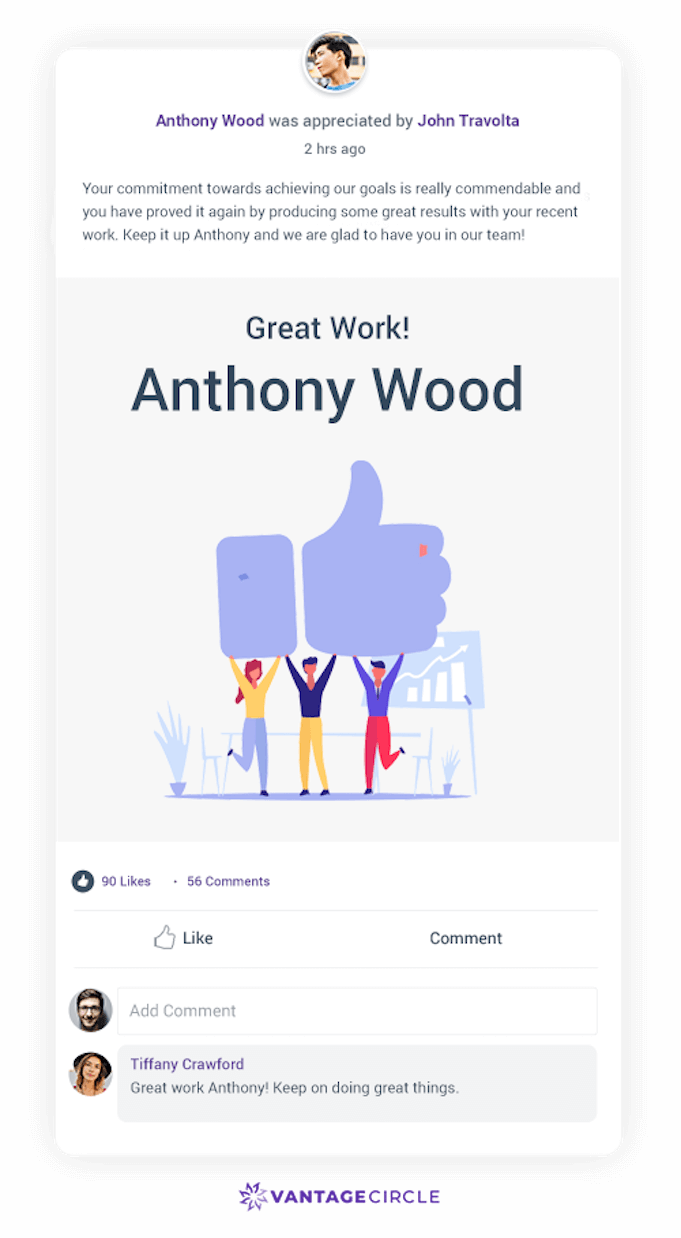
A social feed is an essential tool for team engagement, providing a centralized platform for communication, collaboration, and recognition. With a Social Feed, global teams can effortlessly connect, communicate, and celebrate accomplishments in a dynamic and interactive environment.
Morever, such a feed encourages transparency and raises morale with real-time updates on achievements and milestones. It fosters a culture of celebration and cooperation by promoting cooperation, sharing knowledge, and cross-functional communication.
Additionally, you get real-time feedback and analytics, which can help monitor employee engagement levels and make informed decisions about improving the program. This feature is especially important when managing a global team, as it can be difficult to gauge employee engagement levels in real time.
Schedule a free demo to see how!
6. Fair and equitable rewarding
When executing organizational-wide initiatives like employee awards and recognition programs, global companies can encounter certain challenges. One big issue is the conversion of reward points when recognizing employees worldwide.
Consider this scenario:
Employees M in the USA and N in India are members of the same team who both deserve recognition for their excellent job.
Employee M is rewarded with 10 dollars for their achievements. Similarly, Employee N in India receives a reward worth 10 dollars, approximately 700 INR, as per the currency conversion.
As a result, due to the lower SOLI in India, the reward holds greater value for Employee N, enabling them to obtain a relatively larger quantity of goods and services compared to Employee M with the same monetary amount.
This discrepancy showcases the impact of SOLI on the perceived value and purchasing power of rewards given to employees in different countries.
The Standard of Living Index (SOLI) is a metric used to gauge living expenses in a specific location, determined by market prices. SOLI varies across different places and countries, where regions with a higher SOLI generally entail higher costs for goods and services than those with a lower SOLI.
This highlights the importance of incorporating a SOLI framework into a rewards system.
How does the SOLI framework benefit your global rewards and recognition?
Fairness: SOLI ensures fairness by considering the varying living expenses across different regions, ensuring employees are recognized and rewarded equitably.
Equitable Rewards: SOLI-based rewards go beyond simple currency conversion, accounting for each location's purchasing power and living costs. This results in rewards with similar value and impact for employees regardless of location.
Accuracy: By incorporating SOLI, the rewards program accurately reflects the economic realities of each region, ensuring employees receive rewards that align with their actual cost of living.
Simplified Management: Vantage Rewards, with its SOLI feature, automates converting rewards based on SOLI, making it easy for organizations to implement and manage a fair and consistent recognition program on a global scale.
7. Have a leaderboard
Incorporating a leaderboard system into your global team engagement program can be a powerful tool to tap into the innate human desire for competition, recognition, and achievement. Here's how a leaderboard contributes to global team engagement:
-
Motivation and Goal Setting: The leaderboard creates a competitive environment, fueling employees' desire to improve and climb higher. It inspires them to set higher targets and increases engagement in their activities.
-
Rewards and Recognition: A well crafted leaderboard mechanism can help reward employees with redeemable fitness rewards upon goal achievement, adding an extra layer of motivation. The leaderboard becomes a means for employees to track progress and earn tangible benefits, reinforcing a culture of achievement and sustaining participation.
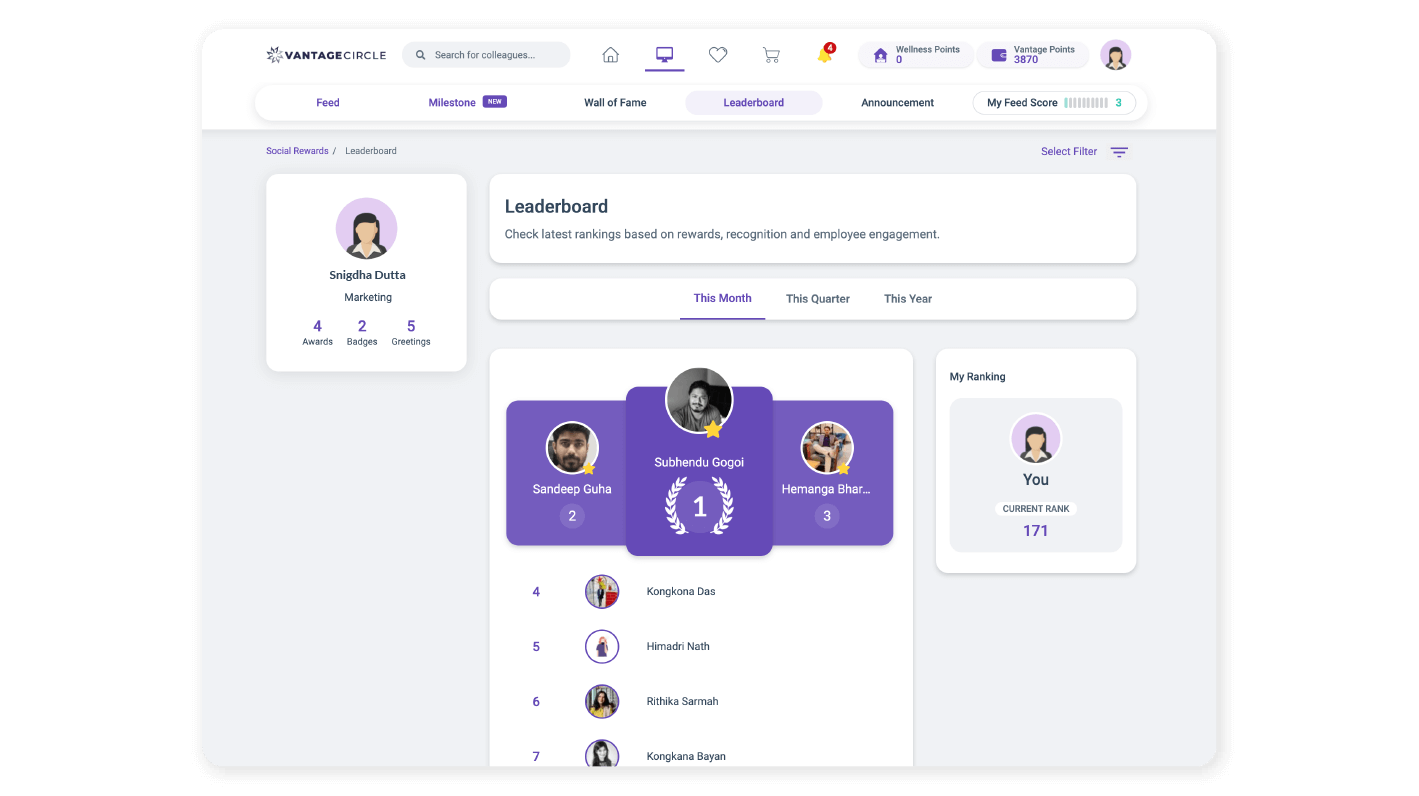
- Team Bonding and Collaboration: The leaderboard fosters camaraderie and collaboration among global teams. Employees can compare scores with colleagues from different locations, fostering friendly competition and promoting team bonding. It creates opportunities for support and learning, fostering a collaborative and engaged community.
8. Gain regular insights into your employees' feelings
Employees far from headquarters often have less access to the team leader. As a result, they may have a harder time getting their concerns noticed and attended to.- Andy Molinsky
Understanding how employees feel is crucial for fostering global team engagement. This can be accomplished by doing frequent check-ins, surveys, or pulse checks to determine the general mood and well-being of the team.
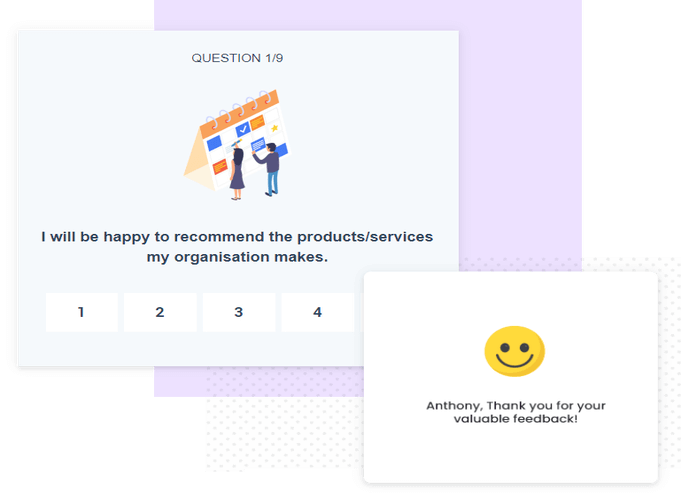
If you struggle to stay connected with your global team, employee survey platforms like Vantage Pulse can greatly help. With frequent polls and anonymous inquiries, it gets super easy to track how everyone feels.
Plus, it's a great way to bridge the culture gap and give international staff the confidence to speak up, regardless of their position or cultural background. They get an equal opportunity to contribute their perspectives and share their unique insights and ideas.
9. Be inclusive
All team members must feel valued and respected to foster an inclusive culture regardless of their differences. It can entail resolving potential concerns or conflicts and promoting open communication, empathy, and respect among team members.
Developing cross-cultural acceptance and understanding is crucial when working in a global team environment. It may entail offering instruction or materials on cultural sensitivity and understanding and inspiring team members to share their distinctive viewpoints and experiences.
At Vantage Circle, we are committed to these principles and have integrated various features promoting diversity, equity, and inclusion into our platform, enhancing our user experience.
The DEI features that we currently have are:
- A multilingual website.
- The "Accessibility (TalkBack) Feature."
- An all-inclusive corporate wellness and fitness product named Vantage Fit.
10. Implement regular virtual team-building activities or social events
Create frequent online social gatherings or team-building activities, like online games or virtual happy hours.
These activities can assist in fostering team unity, raising spirits, and creating a more positive and stimulating workplace. Providing possibilities for cross-functional cooperation or project-based work can aid in team members' development of new skills and their ability to forge closer bonds with one another.
A multinational software development company observed team members who felt distant and alienated, particularly those working in separate time zones. The business introduced a virtual "Coffee Roulette" program to address this.
The program randomly matched team members weekly for a 30-minute online coffee talk. The pairs were selected based on their availability and time zone. It allows team members who may not have interacted much to get to know one another.
The company also offered a list of stimulating conversation starters. It urged team members to submit images of their coffee and workstations during the talks to make the program more engaging.
The team members reported that the program was a big success and that they felt more engaged and connected. Afterward, a poll showed that:
- 72% of workers reported feeling happier at work.
- 63% of workers reported feeling less lonely or depressed.
- While working remotely, 96% of employees felt more connected with the organization.
- 61% were more knowledgeable about the duties of their coworkers.
For more such ideas, read our blog on: 10 Best Virtual Team Building Activities for Remote Employees
11. Leverage the power of the local ambassador
You might not always think to use the influence of local ambassadors while managing a global team engagement program. Employees enthusiastic about engagement and eager to promote the program within their teams or locations can serve as these ambassadors. They can support the program's promotion, boost participation, and offer suggestions for improvement depending on their local team's particular requirements and pursuits.
The idea of leveraging local ambassadors is particularly relevant in a global team engagement program because it helps bridge the gap between global and local perspectives. By tapping into the insights and knowledge of local ambassadors, HR professionals can create more tailored and relevant engagement programs that resonate with local teams and address their specific needs and challenges.
FAQs on Global Team Engagament
1. What are the key components of building engagement globally?
Building engagement entails taking part in its four fundamental components: enablement, energy, empowerment, and encouragement. Each of these four components must be active and thriving in your company if you want to foster an environment where workers are truly engaged.
2. What are five criteria to focus on to improve global employee engagement?
A. Here are the five criteria:
- Give your workers access to open communication channels.
- Employing successful onboarding techniques position your workers for long-term success.
- Increase employee well-being by offering fantastic benefits
- Utilise learning and development initiatives to promote staff growth
- Partner with mobility services to work with global employees.
3. How can I promote a sense of belonging and teamwork among a geographically dispersed global team?
A. Focus on communication, cultural sensitivity, virtual team-building activities, distinct goals and duties, recognition and rewards, regular check-ins, empowerment and autonomy, flexibility, and encouraging a sense of belonging and collaboration to increase participation in a global team.















